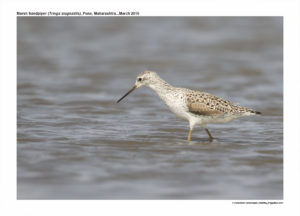Marsh Sandpiper

Marsh Sandpiper Tringa stagnatilis
Etymology:
- Tringa : Greek word for trungasthrush-sized, white-rumped wading bird that bobs its tail, mentioned by Aristotle
- Stagnatilis : Latin word “ belonging to pools or ponds “ derived from stagnum – pool, swamp
Vernacular Names: Pun: Chhanbhichaha, Hindi,Ben: Chhotagotra, Bilerbalubatan, Guj: Gandapugtutvari, Nanililapag, Nanililapagthuthvari, Mar: Chikhlitutari, Ta: Cheetiullan
Distribution in India:Widespread Winter visitor in India (Except Central India and parts of East India).
Description: Size of 22-25 cm.It is has a small body, long legs and straight needle-like bill; wings are dark, rump and back are white, face is pale; upperparts are strongly spotted and blotched with greyish cinnamon and black-brown; foreneck, breast and flanks with black markings. The female is similar but slightly larger than male. The non-breeding adult has plain grey upperparts with narrow white fringes and contrasting dark wing-coverts; face and underparts white.
Habitat: It is found in steppe and boreal wetlands, far inland, preferably in open marshland with fresh grassy cover; brackish shallow marshes; less frequently around salt lakes. After breeding found in margins of inland fresh to brackish wetlands, including paddy fields, swamps, salt pans, salt marshes, sewage farms, estuaries, lagoons and inter-tidal mudflats.
Food Habits: It eats small fish, crustaceans, molluscs and many insects; sometimes plant matter like seeds. It feeds in shallow water, pecking from water surface, while walking steadily and briskly; may glean from vegetation; sometimes probes, jabs or sweeps bill through water; rarely swims. When feeding on fish, may forage socially in dense flock of conspecifics or mixed with other species of Tringa, moving erratically while pecking at prey or running synchronously in one direction while ploughing or scything bill through water. It also follows ducks, egrets and other waders, feeding on prey disturbed by activity of other birds. It feeds singly or in flocks of up to several 100s.
Breeding Habits: They breed in April- June in open grassy steppe and taiga wetlands from easternmost Europe to central Asia. They are monogamous. The male performs typical Tringa display flight, initially rising on rapidly fluttering or vibrating wings, then describing circular or semicircular flight, before diving steeply on fixed wings, and then repeating the performance. The nest is a shallow depression placed on mound, in short vegetation, close to water; usually filled with dry grass. They lay a clutch of 3-5 eggs, with laying interval of 35-43 hours. The incubation period is 20-23 days. Incubation is done by both sexes, mainly by female from last egg.Both sexes tend chicks at first, but female may leave before fledging. The fledging period is 28 days.